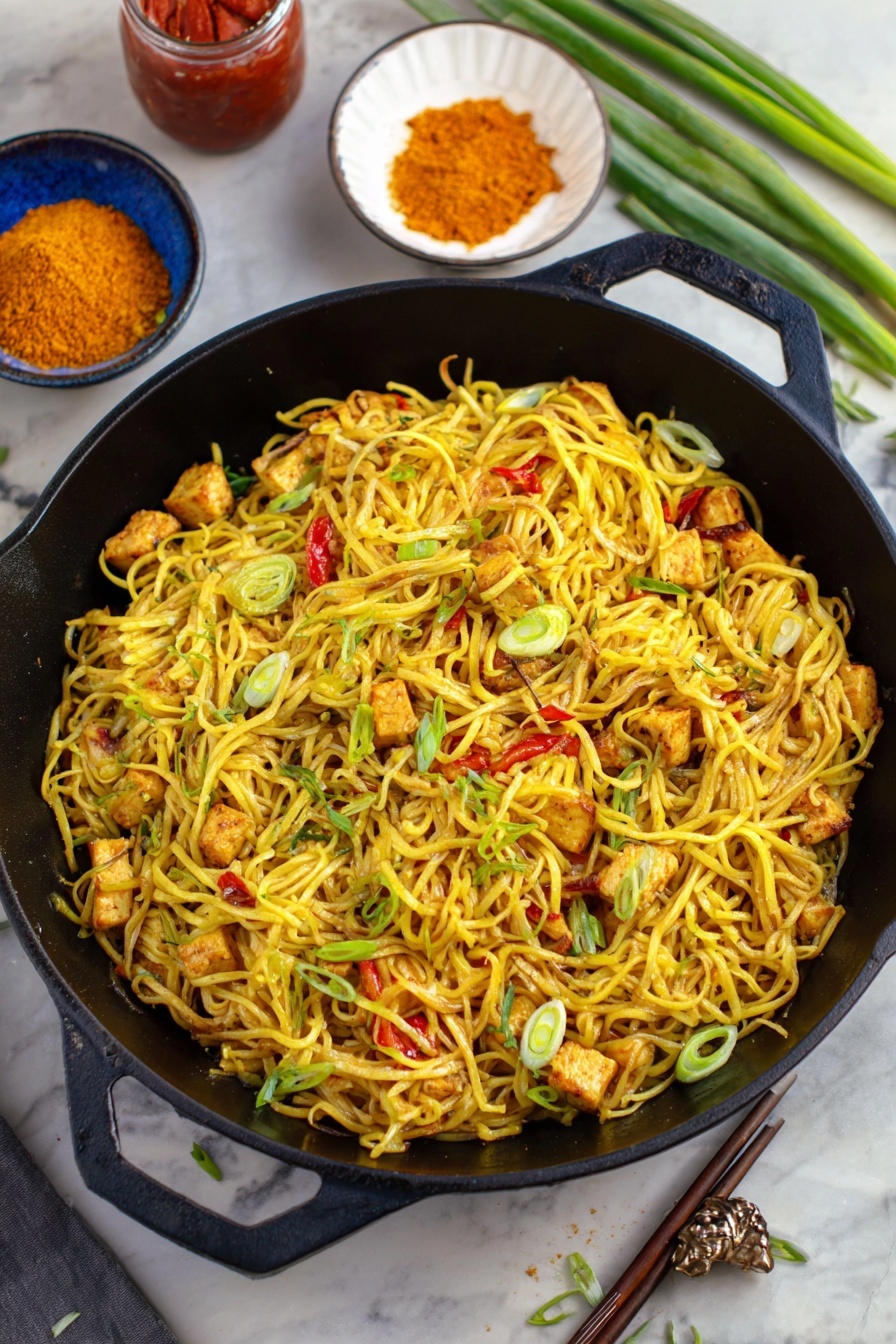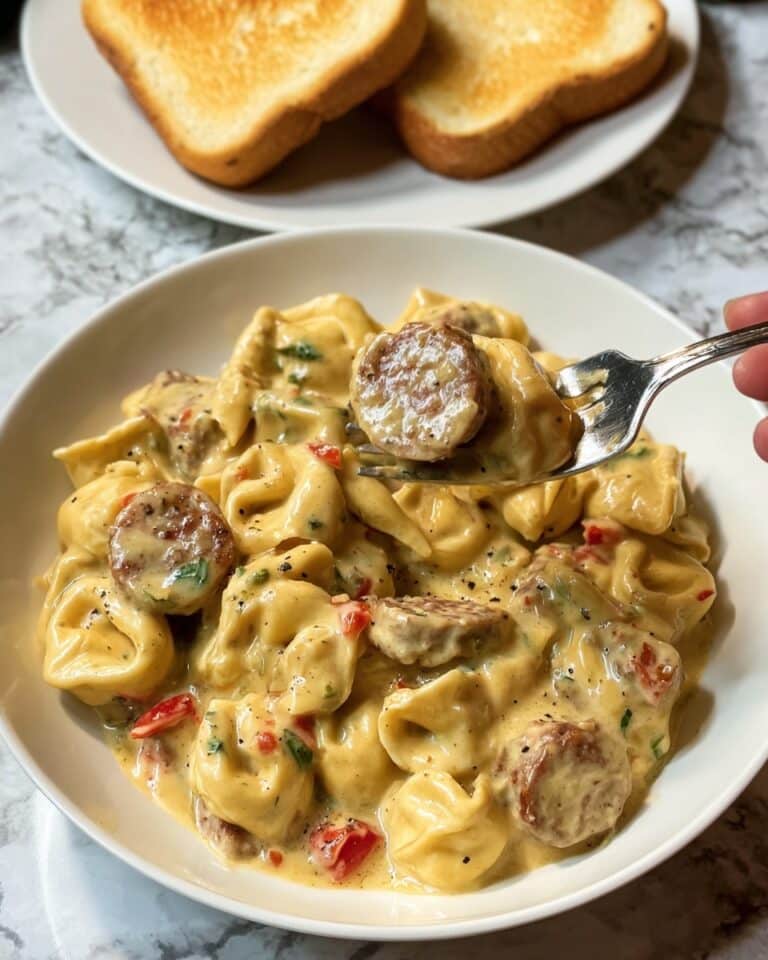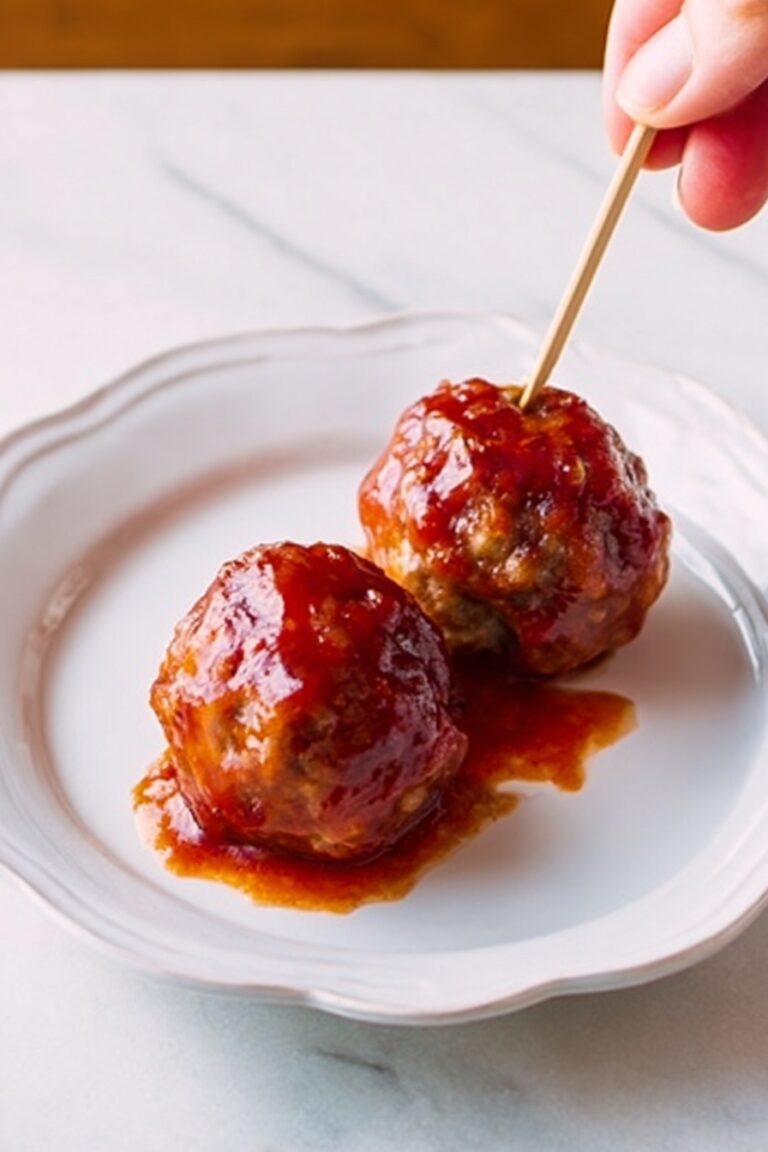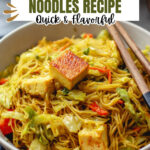Easy Singapore Noodles Recipe
If you’re craving a dish that’s quick, vibrant, and packed with flavor, you’re going to love this Easy Singapore Noodles Recipe. I remember the first time I made it — the blend of curry-spiced noodles with crisp veggies was total magic, and it instantly became a staple in my weeknight rotation. I’m sharing all my secrets here, so you can whip it up effortlessly and impress yourself (and your fam) in no time.
Why This Recipe Works
- Bold Flavors: The curry powder and chili oils create a vibrant, aromatic base that wakes up your taste buds without overwhelming them.
- Simple Ingredients: Most pantry staples and fresh veggies combine effortlessly to make this dish a breeze from start to finish.
- Quick and Easy: From boiling noodles to stir-frying, it all comes together in about 25 minutes—perfect for busy nights.
- Flexible and Customizable: You can easily swap veggies or add proteins like tofu or shrimp to suit your mood and fridge contents.
Ingredients & Why They Work
The balance of noodles, veggies, and bold seasonings in this Easy Singapore Noodles Recipe makes it both satisfying and colorful. Each ingredient brings its own magic, and shopping for them is pretty straightforward if you know what to look for.
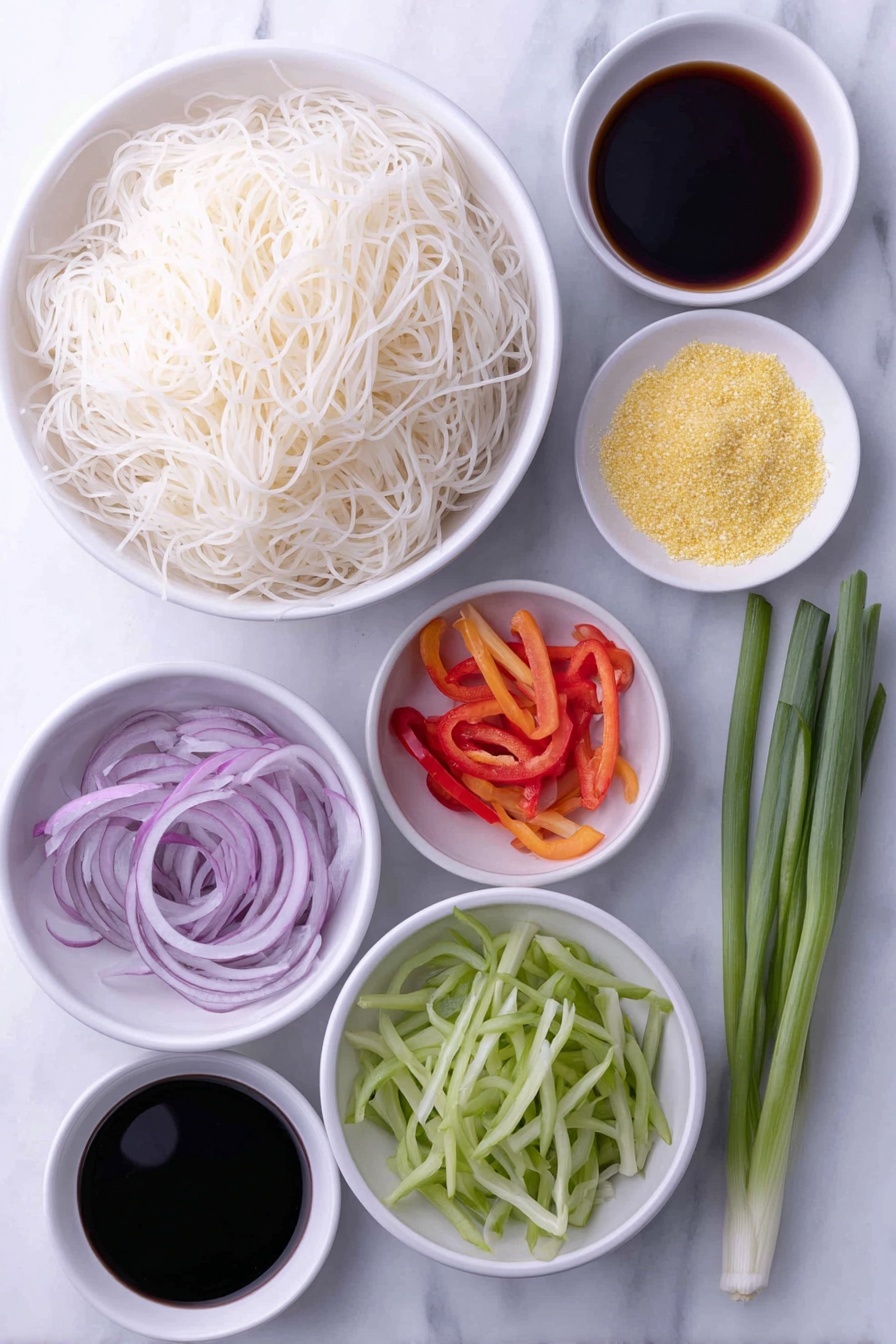
- Sesame Oil: Adds a lovely nutty flavor and helps to give the noodles that authentic wok-fried character.
- Chili Oil (optional): Brings a touch of heat and vibrant chili aroma, perfect if you like a little kick.
- Rice Noodles: The star of the dish—choose thin or medium rice vermicelli for ideal texture and quick cooking.
- Onion: Adds sweetness and depth when sautéed just right, giving a nice contrast to the curry.
- Bell Peppers (Red + Green): Their crunch and natural sweetness brighten up the dish and keep it fresh-tasting.
- Carrot: Adds color and a subtle sweetness; finely slicing helps it cook evenly and quickly.
- French Beans: Provide a crisp bite that balances the soft noodles nicely.
- Curry Powder: This is the heart of the flavor—whether homemade or store-bought, it turns the dish into the classic Singapore noodles you love.
- Soy Sauce: Gives that salty umami boost, melding everything together.
- Rice Vinegar or Regular Vinegar: Adds a tangy brightness that lifts the dish and balances the richness.
- Red Chili Paste (optional): For extra punch and complexity in your sauce.
- Green Onion: Fresh, sharp, and scattered on top at the end—they give a beautiful finishing touch.
Tweak to Your Taste
One of my favorite things about this Easy Singapore Noodles Recipe is how easy it is to make it your own. I’ve tried it with all kinds of veggies and proteins, and each version feels fresh and satisfying. Don’t be shy—play around and see what works best for you.
- Veggie Swap: I’ve tossed in snap peas, baby corn, and even mushrooms when my usual veggies weren’t around, and it’s always a hit.
- Protein Boost: Adding tofu cubes or cooked shrimp turns this into a heartier meal, which my family really loves on busy nights.
- Mild or Spicy: Feel free to dial down or up the chili paste and chili oil depending on your heat tolerance.
- Gluten-Free Option: Just double-check your soy sauce and opt for tamari if needed—it’s easy to swap and still tastes amazing.
Step-by-Step: How I Make Easy Singapore Noodles Recipe
Step 1: Boil the Noodles Perfectly
Start by bringing 1-2 quarts of water to a boil in a large stockpot. When it’s boiling, add a pinch of salt and a tablespoon of oil—this keeps the rice noodles from sticking together. Toss in your rice noodles, stirring gently as they cook for about 3 minutes. Remember, rice noodles cook fast, typically between 2 to 4 minutes, so keep an eye on them to avoid turning mushy. Once cooked but still firm to the bite, drain them and rinse under cold water to stop the cooking process. Run your fingers through the noodles gently to separate any clumps.
Step 2: Sauté the Vegetables with Flavor
Heat sesame oil and the optional chili oil in your wok or a large skillet over medium-high heat. When the oil shimmers, throw in the sliced onions. Sauté until they start to turn translucent and just a hint golden. Next, add the bell peppers, carrot, and French beans. Stir frequently so the veggies cook evenly and stay crisp-tender. You want them softened but still with some bite—this fresh crunch is what makes Singapore noodles so delicious.
Step 3: Bring on the Sauces & Noodles
Once your vegetables look just about tender, stir in the red chili paste (if you’re using it), soy sauce, and the vinegar. Coat the veggies well, letting those flavors meld for a minute. Then, add your drained noodles to the wok. Using tongs or chopsticks, gently toss everything together while cooking on high heat for another 1-2 minutes. The goal is to evenly coat the noodles in the tangy sauce and blend in the veggies without breaking the noodles apart.
Step 4: Finish with Curry Powder & Garnish
Finally, sprinkle the curry powder over the noodles and toss well until it’s completely combined. You’ll immediately notice that distinct Singapore noodles fragrance that’s so irresistible. Remove from heat and scatter chopped green onions on top for a fresh pop of color and flavor. Serve up right away for the best texture and taste.
Pro Tips for Making Easy Singapore Noodles Recipe
- Don’t Overcook Your Noodles: They look done very quickly in boiling water; stopping cooking with cold water prevents sogginess.
- High Heat Stir-Fry: Using high heat at the end helps everything come together without steaming the veggies too much.
- Make Your Own Curry Powder: If you have time, homemade curry powder adds a bright, fresh layer of flavor that’s hard to beat.
- Avoid Clumping: Coat your noodles with oil right after cooking and rinse under cold water to keep them separate and easy to stir-fry.
How to Serve Easy Singapore Noodles Recipe
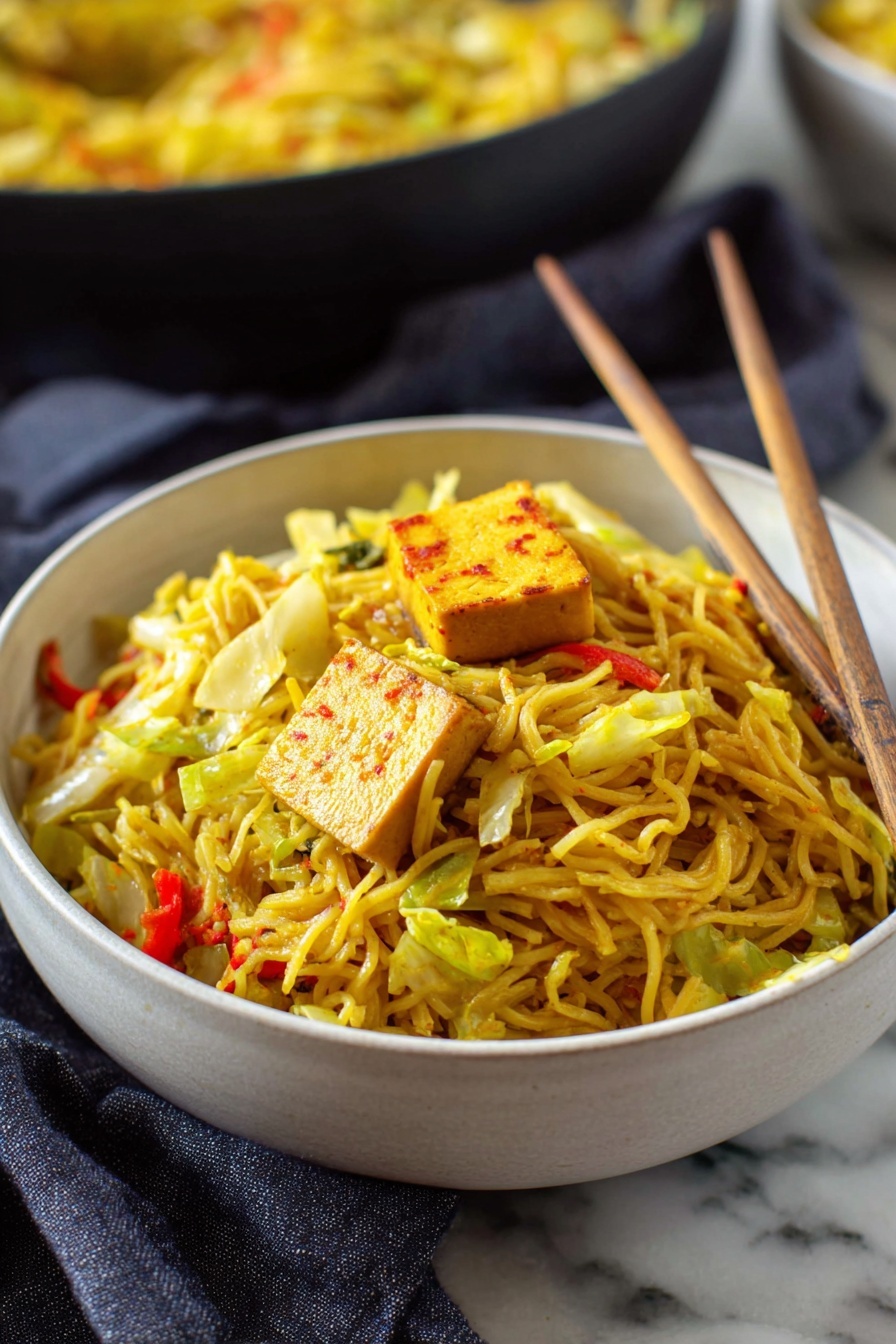
Garnishes
I always top my Singapore noodles with freshly chopped green onions for a bit of crunch and gentle onion flavor. Sometimes, I sprinkle toasted sesame seeds for extra nuttiness, and a wedge of lime on the side is great if you want a zesty kick. Fresh cilantro leaves also brighten up the plate beautifully if you enjoy that herbaceous note.
Side Dishes
Pair your Easy Singapore Noodles with simple sides like steamed dumplings, crunchy Asian slaw, or even quick pickled cucumbers to add some tang and texture contrast. On busy evenings, a bowl of miso soup or a crisp green salad rounds the meal nicely without too much fuss.
Creative Ways to Present
For special occasions, try serving the noodles in individual lettuce cups or bamboo steamers for a fun twist. You can also plate them in a nest shape and top with grilled shrimp or tofu for an eye-catching presentation that makes dinner feel festive and special.
Make Ahead and Storage
Storing Leftovers
Leftover Easy Singapore Noodles keep well in an airtight container in the fridge for 2-3 days. I usually portion them out right after cooking so I can grab individual servings easily. Before storing, let the noodles cool completely to avoid sogginess caused by trapped steam.
Freezing
I don’t generally freeze Singapore noodles because the texture of the rice noodles can suffer from thawing. If you want to freeze, try freezing the vegetables and sauce separately from the noodles to preserve their integrity better.
Reheating
Reheat leftovers gently in a skillet over medium heat, adding a splash of water or broth to loosen things up as you toss. Avoid microwaving if you can, as it can make the noodles mushy. Stir-frying keeps that crisp-tender texture you worked so hard for!
FAQs
-
Can I use other types of noodles for Easy Singapore Noodles Recipe?
Absolutely! While rice vermicelli is traditional, you can use thin egg noodles, soba, or even spaghetti in a pinch. Just adjust cooking times accordingly and keep in mind that flavors absorb differently depending on noodle type.
-
How spicy is this Easy Singapore Noodles Recipe?
This recipe is pretty flexible on heat — you can leave out chili oil and red chili paste if you prefer mild, or add as much as you like to suit your spice tolerance. The curry powder also adds warmth without overwhelming heat.
-
Is this recipe gluten-free?
The core recipe can be gluten-free if you use gluten-free soy sauce or tamari, and confirm your curry powder and chili paste contain no gluten additives. Otherwise, it’s naturally free of wheat-based ingredients.
-
Can I prepare this dish ahead of time?
While you can prepare the ingredients in advance, it’s best to cook the noodles just before serving to avoid sogginess. Veggies can be chopped early, and sauces mixed ahead to speed up cooking time.
Final Thoughts
This Easy Singapore Noodles Recipe holds a special place in my kitchen because it’s one of those dishes that turns ordinary ingredients into something bright, flavorful, and satisfying in less than half an hour. I hope when you try it, you’ll find it just as comforting and fun to make as I do. So, next time you’re pondering what to cook that’s quick, colorful, and tasty, give this a go—you’ve got this!
Print
Easy Singapore Noodles Recipe
- Prep Time: 10 minutes
- Cook Time: 15 minutes
- Total Time: 25 minutes
- Yield: 2 servings
- Category: Main Course
- Method: Stovetop
- Cuisine: Asian
- Diet: Vegetarian
Description
Singapore Noodles is a vibrant and flavorful stir-fried dish featuring tender rice noodles tossed with a variety of sautéed vegetables and aromatic curry powder. This quick and colorful recipe combines the nuttiness of sesame oil, the tang of vinegar, and the subtle heat of chili paste, making it a perfect light lunch or dinner option inspired by Asian flavors.
Ingredients
Main Ingredients
- 2 tablespoons sesame oil
- 1 tablespoon chili oil (optional)
- Salt as needed
- Rice noodles (about 200 grams)
- 1 small onion, sliced
- ½ bell pepper (red + green), finely sliced
- 1 carrot, finely sliced
- ⅓ cup French beans, diced
- 1-2 tablespoons curry powder (adjust to taste)
- 1-2 tablespoons soy sauce (adjust as needed)
- 1-2 tablespoons rice vinegar or regular vinegar
- 1 teaspoon red chili paste (optional)
- 2 stalks green onion, chopped for garnish
Curry Powder Ingredients (Optional Homemade Mix)
- 1 tablespoon cardamom
- 1 tablespoon ground coriander
- 2 teaspoons cumin seeds
- 1 teaspoon mustard seeds
- 1 teaspoon cayenne powder
- ½ teaspoon ground ginger powder
- 1 teaspoon turmeric
- ½ teaspoon black peppercorns
Instructions
- Boil Noodles: In a large stockpot, bring 2 quarts of water to a boil. Once boiling, add salt and 1 tablespoon of oil to the water. Add the rice noodles and cook for 3 minutes, stirring occasionally to prevent sticking. The noodles should be just tender but not mushy.
- Drain and Rinse: Strain the cooked noodles in a colander and rinse them under cold running water to halt the cooking process. Gently separate the noodles with your fingers to prevent clumping.
- Sauté Vegetables: Heat sesame oil and chili oil (if using) in a wok over medium-high heat. Add sliced onions and sauté until they begin to change color. Then add bell peppers, carrots, and French beans. Cook until the vegetables start to become tender.
- Add Sauces: Stir in the red chili paste, soy sauce, and vinegar. Mix thoroughly so that the vegetables are well coated with the sauces.
- Toss Noodles: Add the drained rice noodles to the wok. Using tongs, toss the noodles with the vegetables and sauce mixture on high heat for 1-2 minutes to combine and heat through.
- Add Curry Powder: Sprinkle in the curry powder and continue tossing the noodles until the curry is evenly distributed and the flavors meld together.
- Garnish and Serve: Remove from heat and garnish with chopped green onions. Serve immediately while hot for best flavor and texture.
Notes
- You can use store-bought curry powder for convenience, but homemade fresh masala significantly enhances the flavor.
- Feel free to add other vegetables or protein sources like tofu, nuts, or shrimp to customize the dish.
- Avoid overcooking the rice noodles to prevent them becoming sticky and unappealing.
- Chili oil and red chili paste are optional and can be adjusted to your preferred spice level.
- If you don’t have rice vinegar, regular vinegar can be substituted with a slight difference in flavor.
Nutrition
- Serving Size: 100 grams
- Calories: 228 kcal
- Sugar: 4 g
- Sodium: 10992 mg
- Fat: 22 g
- Saturated Fat: 3 g
- Unsaturated Fat: 19 g
- Trans Fat: 0 g
- Carbohydrates: 8 g
- Fiber: 3 g
- Protein: 2 g
- Cholesterol: 0 mg

